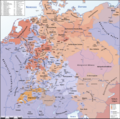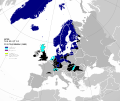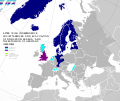History of Protestantism
| Part of a series on |
| Protestantism |
|---|
 |
|
|
Since the 16th century, major factors affecting Protestantism have been the Catholic
Overview
One of the early
Both Wycliffe and Hus preached against indulgences.[3][4] Hus wrote his Six Errors, fixed to the door of his church, in which he criticized corruption of the clergy[5] and touched on other topics which under the later Luther became the key to the Reformation. After the Battle of White Mountain, persecuted Hussites established minor churches such as the Unity of the Brethren (and its international branch Moravian Church).
Those early reformers influenced
After excommunicating Luther in 1521 with the papal bull
In the course of this religious upheaval, the
While the
The
In the 20th century, Protestantism was becoming increasingly fragmented with
In the 21st century, Protestantism continues to divide, while simultaneously expanding on a worldwide scale largely due to rising
Historical maps
Europe
-
Distribution of Protestantism and Roman Catholicism in Central Europe on the eve of the Thirty Years' War (1618)Crypto-Protestantsare not shown.
-
Approximate spread of Protestantism after the Reformation, and following the Counter-Reformation.Crypto-Protestantsare not shown.
-
Approximate spread of Protestantism at the Reformation's peak. Islam is marked in red.Crypto-papists, and Crypto-Muslimsare not shown.
-
The Protestant Reformation at its peak
-
After the Counter-Reformation.Crypto-Protestantsare not shown.
-
After theCrypto-Protestantsare not shown.
-
Modern spread after theExpulsions of Germans
World
-
Countries by percentage of Protestants in 1545.
-
Countries by percentage of Protestants in 1710.
-
Countries by percentage of Protestants in 1938.
-
Countries by percentage of Protestants in 2010.
-
Protestant majority countries in 1938.
-
Protestant majority countries in 2010.
Origins
Protestants generally trace to the 16th century their separation from the Catholic Church. Mainstream Protestantism began with the
Roots
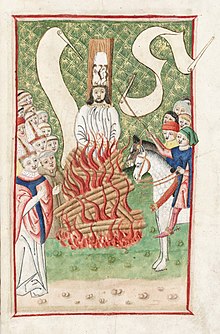
In the 9th century Claudius of Turin foreshadowed many Protestant views, and had a fanatical zeal for iconoclasm. Claudius of Turin denied the power of the papacy, and the role of good works in salvation, thus believing in faith alone.[13][14][15] Gottschalk of Orbais was another 9th century theologian, who taught double predestination and grace oriented views of salvation, mirroring the doctrine of faith alone.[16][17][18] Gottschalk was defended by Ratramnus, who denied transubstantiation and whose writings influenced some reformers.[19]
Unrest due to the
The
Following the breakdown of monastic institutions and
The outcome of the
But as recovery and prosperity progressed, enabling the population to reach its former levels in the late 15th and 16th centuries, the combination of a newly-abundant labor supply and improved productivity, was a mixed blessing for many segments of Western European society. Despite tradition, landlords started to exclude peasants from "common lands". With trade stimulated, landowners increasingly moved away from the manorial economy. Woollen manufacturing greatly expanded in France, Germany, and the Netherlands and new textile industries began to develop.
The invention of movable type led to Protestant zeal for translating the Bible and getting it into the hands of the laity.
The "humanism" of the Renaissance period stimulated unprecedented academic ferment, and a concern for academic freedom. Ongoing, earnest theoretical debates occurred in the universities about the nature of the church, and the source and extent of the authority of the papacy, of councils, and of princes.
16th century

Protests against Rome began in earnest when
Parallel to events in Germany, a movement began in Switzerland under the leadership of
), sometimes breaking from Rome or from the Protestants, or forming outside of the churches.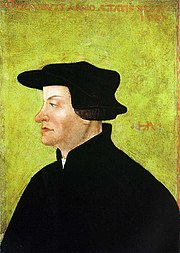
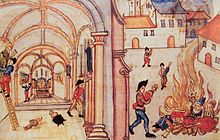
After this first stage of the Reformation, following the excommunication of Luther and condemnation of the Reformation by the Pope, the work and writings of John Calvin were influential in establishing a loose consensus among various groups in Switzerland, Scotland, Hungary, Germany and elsewhere.
The Reformation foundations engaged with
The political separation of the

Martin Luther, John Calvin, and Ulrich Zwingli are considered Magisterial Reformers because their reform movements were supported by ruling authorities or "magistrates". Frederick the Wise not only supported Luther, who was a professor at the university he founded, but also protected him by hiding Luther in Wartburg Castle in Eisenach. Zwingli and Calvin were supported by the city councils in Zürich and Geneva. Since the term "magister" also means "teacher", the Magisterial Reformation is also characterized by an emphasis on the authority of a teacher. This is made evident in the prominence of Luther, Calvin, and Zwingli as leaders of the reform movements in their respective areas of ministry.
Because of their authority, they were often criticized by Radical Reformers as being too much like the Roman Popes. For example, Radical Reformer Andreas von Bodenstein Karlstadt referred to the Wittenberg theologians as the "new papists".[22]
Impact of humanism
The frustrated reformism of the humanists, ushered in by the Renaissance, contributed to a growing impatience among reformers. Erasmus and later figures like Martin Luther and Zwingli would emerge from this debate and eventually contribute to another major schism of Christendom. The crisis of theology beginning with William of Ockham in the fourteenth century was occurring in conjunction with the new burgher discontent. Since the breakdown of the philosophical foundations of scholasticism, the new nominalism did not bode well for an institutional church legitimized as an intermediary between man and God. New thinking favored the notion that no religious doctrine can be supported by philosophical arguments, eroding the old alliance between reason and faith of the medieval period laid out by Thomas Aquinas.

The major individualistic reform movements that revolted against medieval scholasticism and the institutions that underpinned it were
The polarization of the scholarly community in Germany over the
Humanism's intellectual anti-clericalism would profoundly influence Luther. The increasingly well-educated middle sectors of Northern Germany, namely the educated community and city dwellers would turn to Luther's rethinking of religion to conceptualize their discontent according to the cultural medium of the era. The great rise of the burghers, the desire to run their new businesses free of institutional barriers or outmoded cultural practices, contributed to the appeal of humanist individualism. To many, papal institutions were rigid, especially regarding their views on just price and usury. In the North, burghers and monarchs were united in their frustration for not paying any taxes to the nation, but collecting taxes from subjects and sending the revenues disproportionately to the Pope in Italy.
These trends heightened demands for significant reform and revitalization along with anticlericalism. New thinkers began noticing the divide between the priests and the flock. The clergy, for instance, were not always well-educated. Parish priests often did not know
Luther borrowed from the humanists the sense of individualism, that each man can be his own priest (an attitude likely to find popular support considering the rapid rise of an educated urban middle class in the North), and that the only true authority is the
Lutherans and the Holy Roman Empire

Luther affirmed a theology of the
At the
Another setback for the Reformation came in Brandenburg. The Elector of Brandenburg,
Though Charles V fought the Reformation, it is no coincidence that the reign of his nationalistic predecessor Maximilian I saw the beginning of the movement. While the centralized states of western Europe had reached accords with the Vatican permitting them to draw on the rich property of the church for government expenditures, enabling them to form state churches that were greatly autonomous of Rome, similar moves on behalf of the Empire were unsuccessful so long as princes and prince bishops fought reforms to drop the pretension of the secular universal empire.
Protestant Reformation
The authority of the Catholic Church has been constantly challenged during centuries, both in theory with Hus and Wycliffe and in practice during the Investiture Controversy of the 11th and 12th centuries. Arnulf (bishop of Orléans)[25] in the 10th century became the first person on record to call a pope the Antichrist, a charge that was repeated by the Waldensians and also Luther when he burned the very papal bull, Exsurge Domine which commanded him to burn his own books. Necessary groundwork had thus been laid long before Luther[3] with significant earlier attempts to reform the Roman Catholic Church – such as those of Peter Waldo and John Wycliffe. First change of religion in an entire country came with Jan Hus, executed in 1415, whose successors became the chief force[26] in the Kingdom of Bohemia for several centuries. Both Wycliffe and Hus preached against indulgences,[3][4] criticized corruption of the clergy[5] and opened other topics which under the later Luther became the key to Reformation. The movements based on these early reform movements, such are also considered Protestant today, although their origins date back to more than 100 years before Luther. In particular, the Waldensians who survived the Counter-Reformation affiliated with the Reformed Church (which is more commonly known to be Protestant), and still do today.
In the early 16th century, the church was confronted with the challenge posed by Martin Luther to the traditional teaching on the church's doctrinal authority and to many of its practices as well. The seeming inability of Pope Leo X (1513–1521) and those popes who succeeded him to comprehend the significance of the threat that Luther posed – or, indeed, the alienation of many Christians by the corruption that had spread throughout the church – was a major factor in the rapid growth of the Protestant Reformation. By the time the need for a vigorous, reforming papal leadership was recognized, much of northern Europe had already converted to Protestantism.
Bohemia

The Hussites were a Christian movement in the Kingdom of Bohemia following the teachings of Czech reformer Jan Hus.
Czech reformer and university professor Jan Hus (c. 1369–1415) became the best-known representative of the Bohemian Reformation and one of the forerunners of the Protestant Reformation. Jan Hus was declared heretic and executed – burned at stake – at the Council of Constance in 1415 where he arrived voluntarily to defend his teachings.
Hussites, a predominantly religious movement, were propelled by social issues and strengthened Czech national awareness. In 1417, two years after the execution of Jan Hus, the Czech reformation quickly became the chief force in the country.
After the
Two churches with Hussite roots are now second and third biggest churches in the predominantly agnostic country: Czech Brethren (which gave origin to the international church known as the Moravian Church) and Czechoslovak Hussite Church.
Germany

Martin Luther was a
Luther taught that salvation is a free gift of God and received only through true faith in Jesus as redeemer from sin. His theology challenged the authority of the papacy by adducing the Bible as the only infallible source of Christian doctrine[33] and countering "sacerdotalism" in the doctrine that all baptized Christians are a universal priesthood.[34]
Luther's refusal to retract his writings in confrontation with the Holy Roman Emperor Charles V at the
In 1516–1517,
On 31 October 1517, Luther wrote to
Luther objected to a saying attributed to Johann Tetzel that "As soon as the coin in the coffer rings, the soul from purgatory springs,"[42] insisting that, since forgiveness was God's alone to grant, those who claimed that indulgences absolved buyers from all punishments and granted them salvation were in error. Christians, he said, must not slacken in following Christ on account of such false assurances.
According to Walter Krämer, Götz Trenkler, Gerhard Ritter and Gerhard Prause,

It wasn't until January 1518 that friends of Luther translated the 95 Theses from Latin into German, printed, and widely copied, making the controversy one of the first in history to be aided by the
That autumn, Johann Eck proclaimed the bull in Meissen and other towns. Karl von Miltitz, a papal nuncio, attempted to broker a solution, but Luther, who had sent the Pope a copy of his conciliatory On the Freedom of a Christian (which the Pope refused to read) in October, publicly set fire to the bull and decretals at Wittenberg on 10 December 1520,[47] an act he defended in Why the Pope and his Recent Book are Burned and Assertions Concerning All Articles.
As a consequence, Luther was excommunicated by Leo X on 3 January 1521, in the bull Decet Romanum Pontificem.

In 1534,
Switzerland
Zwingli
Parallel to events in Germany, a movement began in Switzerland under the leadership of
), sometimes breaking from Rome or from the Protestants, or forming outside of the churches.John Calvin

Following the excommunication of Luther and condemnation of the Reformation by the Pope, the work and writings of John Calvin were influential in establishing a loose consensus among various groups in Switzerland, Scotland, Hungary, Germany and elsewhere.
Geneva became the unofficial capital of the Protestant movement, led by the Frenchman,
The Reformation foundations engaged with
All of Scandinavia ultimately adopted Lutheranism over the course of the sixteenth century, as the monarchs of Denmark (who also ruled Norway and Iceland) and Sweden (who also ruled Finland) converted to that faith.
In Sweden the Reformation was spearheaded by Gustav Vasa, elected king in 1523. Friction with the pope over the latter's interference in Swedish ecclesiastical affairs led to the discontinuance of any official connection between Sweden and the papacy from 1523.[53] Four years later, at the Diet of Västerås, the king succeeded in forcing the diet to accept his dominion over the national church. The king was given possession of all church property, church appointments required royal approval, the clergy were subject to the civil law, and the "pure Word of God" was to be preached in the churches and taught in the schools—effectively granting official sanction to Lutheran ideas.[53] Thus, in 1527 Sweden became the first nation-state to officially adopt Protestantism.[54]
Under the reign of
England
The separation of the

In England, the Reformation followed a different course from elsewhere in Europe. There had long been a strong strain of anti-clericalism, and England had already given rise to the
The different character of the English Reformation was driven initially by the political necessities of
There were some notable opponents to the
Puritans

The success of the
The early Puritan movement (late 16th century–17th century) was
The later Puritan movements were often referred to as
The most famous and well-known emigration to America was the migration of the Puritan separatists from the Anglican Church of England, who fled first to Holland, and then later to America, to establish the English colonies of New England, which later became a part of the United States.
These Puritan separatists were also known as "
The original intent of the colonists was to establish spiritual Puritanism, which had been denied them in England and the rest of Europe to engage in peaceful commerce with England and the Native American Indians and to Christianize the peoples of the Americas.
Scotland
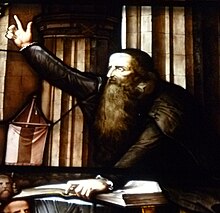
The Reformation in Scotland's case culminated ecclesiastically in the re-establishment of the church along
is regarded as the leader of the Scottish Reformation.The
The Scottish Reformation decisively shaped the
A spiritual revival also broke out among Catholics soon after Martin Luther's actions, and led to the
France
Protestantism also spread into France, where the Protestants came to be known as "Huguenots."

Though not personally interested in religious reform,
Following the Affair of the Placards, culprits were rounded up, at least a dozen heretics were put to death, and the persecution of Protestants increased.[56] One of those who fled France at that time was John Calvin, who emigrated to Basel in 1535 before eventually settling in Geneva in 1536. Beyond the reach of the French kings in Geneva, Calvin continued to take an interest in the religious affairs of his native land including the training of ministers for congregations in France.
As the number of Protestants in France increased, the number of heretics in prisons awaiting trial also grew. As an experimental approach to reduce the caseload in Normandy, a special court just for the trial of heretics was established in 1545 in the Parlement de Rouen.[57][58] When Henry II took the throne in 1547, the persecution of Protestants grew and special courts for the trial of heretics were also established in the Parlement de Paris. These courts came to be known as "La Chambre Ardente" ("the fiery chamber") because of their reputation of meting out death penalties on burning gallows.[59]
Despite heavy persecution by
French Protestantism, though its appeal increased under persecution, came to acquire a distinctly political character, made all the more obvious by the noble conversions of the 1550s. This had the effect of creating the preconditions for a series of destructive and intermittent conflicts, known as the Wars of Religion. The civil wars were helped along by the sudden death of Henry II in 1559, which saw the beginning of a prolonged period of weakness for the French crown. Atrocity and outrage became the defining characteristic of the time, illustrated at its most intense in the St. Bartholomew's Day massacre of August 1572, when the Catholic Church annihilated between 30,000 and 100,000 Huguenots across France.[60] The wars only concluded when Henry IV, himself a former Huguenot, issued the Edict of Nantes, promising official toleration of the Protestant minority, but under highly restricted conditions. Catholicism remained the official state religion, and the fortunes of French Protestants gradually declined over the next century, culminating in Louis XIV's Edict of Fontainebleau—which revoked the Edict of Nantes and made Catholicism the sole legal religion of France. In response to the Edict of Fontainebleau, Frederick William of Brandenburg declared the Edict of Potsdam, giving free passage to French Huguenot refugees, and tax-free status to them for 10 years.
Netherlands

The Reformation in the Netherlands, unlike in many other countries, was not initiated by the rulers of the
Harsh persecution of Protestants by the Spanish government of Philip II contributed to a desire for independence in the provinces, which led to the Eighty Years' War and eventually, the separation of the largely Protestant Dutch Republic from the Catholic-dominated Southern Netherlands, the present-day Belgium.
Hungary
Much of the population of the Kingdom of Hungary adopted Protestantism during the sixteenth century. After the 1526 Battle of Mohács the Hungarian people were disillusioned by the inability of the government to protect them.
The spread of Protestantism in the country was aided by its large ethnic German minority, which could understand and translate the
In the more independent northwest the rulers and priests, protected now by the Habsburg monarchy which had taken up the fight against the Turks, defended the old Catholic faith. They sent Protestants to prison and to the stake wherever they could. Such strong measures fanned the flames of protest.[citation needed] Leaders of the Protestants included Matthias Biro Devai, Michael Sztarai, and Stephen Kis Szegedi.
Protestants likely formed a majority of Hungary's population at the close of the sixteenth century, but Counter-Reformation efforts in the seventeenth century reconverted a majority of the kingdom to Catholicism.[62] A significant Protestant minority remained, most of it adhering to the Calvinist faith.
In 1558 the
There were a series of other successful and unsuccessful anti-Habsburg, i.e. anti-Austrian, (requiring equal rights and freedom for all Christian religions) uprisings between 1604 and 1711; the uprisings were usually organized from Transylvania. The constrained Habsburg Counter-Reformation efforts in the seventeenth century reconverted the majority of the kingdom to Catholicism.
Nineteenth century

Historian Kenneth Scott Latourette argues that the outlook for Protestantism at the start of the 19th century was discouraging. It was a regional religion based in northwestern Europe, with an outpost in the sparsely settled United States. It was closely allied with government, as in Scandinavia, the Netherlands, Prussia, and especially Great Britain. The alliance came at the expense of independence, as the government made the basic policy decisions, down to such details as the salaries of ministers and location of new churches.
The dominant intellectual currents of the Enlightenment promoted rationalism, and most Protestant leaders preached a sort of deism. Intellectually, the new methods of historical and anthropological study undermine automatic acceptance of biblical stories, as did the sciences of geology and biology. Industrialization was a strongly negative factor, as workers who moved to the city seldom joined churches. The gap between the church and the unchurched grew rapidly, and secular forces, based both in socialism and liberalism undermined the prestige of religion.
Despite the negative forces, Protestantism demonstrated a striking vitality by 1900. Shrugging off Enlightenment rationalism, Protestants embraced
Britain
In England, Anglicans emphasized the historically Catholic components of their heritage, as the High Church element reintroduced vestments and incense into their rituals, against the opposition of Low Church evangelicals.
Germany
Two main developments reshaped religion in Germany. Across the land, there was a movement to unite the larger Lutheran and the smaller Reformed Protestant churches. The churches themselves brought this about in Baden, Nassau, and Bavaria. However, in Prussia King
Great Awakenings
| Great Awakenings in America |
|---|
The "Great Awakenings" were periods of rapid and dramatic religious revival in American religious history, beginning in the 1730s.
First Great Awakening
The "First Great Awakening" (or sometimes "The Great Awakening") was a wave of religious enthusiasm among Protestants that swept the American colonies in the 1730s and 1740s, leaving a permanent impact on American religion. It emphasized the traditional Reformed virtues of Godly preaching, rudimentary liturgy, and a deep sense of personal guilt and redemption by Christ Jesus. It resulted from powerful preaching that deeply affected listeners (already church members). Historian Sydney E. Ahlstrom saw it as part of a "great international Protestant upheaval" that also created
Unlike the
Second Great Awakening
The "Second Great Awakening" (1790–1840s) was the second great religious revival in
In New England, the renewed interest in religion inspired a wave of social activism. In western New York, the spirit of revival encouraged the emergence of the Restoration Movement, the Latter Day Saint movement, Adventism and the Holiness movement. In the west especially—at Cane Ridge, Kentucky and in Tennessee—the revival strengthened the Methodists and the Baptists and introduced into America a new form of religious expression—the Scottish camp meeting.
The Second Great Awakening made its way across the frontier territories, fed by intense longing for a prominent place for God in the life of the new nation, a new liberal attitude toward fresh interpretations of the Bible, and a seemingly contagious experience of zeal for authentic spirituality. As these revivals spread, they gathered converts to Protestant sects of the time. However, the revivals eventually moved freely across denominational lines, with practically identical results, and went farther than ever toward breaking down the allegiances which kept adherents to these denominations loyal to their own. Consequently, the revivals were accompanied by a growing dissatisfaction with Evangelical churches and especially with the doctrine of
Various unaffiliated movements arose that were often
to restore Christianity to its original form.Third Great Awakening

The "Third Great Awakening" was a period of religious activism in American history from the late 1850s to the 1900s. It affected pietistic Protestant denominations and had a strong sense of social activism. It gathered strength from the
With
20th century
Protestant Christianity in the 20th century was characterized by accelerating fragmentation. The century saw the rise of both liberal and conservative splinter groups, as well as a general secularization of Western society. The Roman Catholic Church instituted many reforms in order to modernize. Missionaries also made inroads in the
Another movement which grew up over the 20th century was
The 1950s saw a boom in the Evangelical church in America. The post–World War II prosperity experienced in the U.S. also had its effects on the church. Although simplistically referred to as "morphological fundamentalism", the phrase nonetheless accurately describes the physical developments experienced. Church buildings were erected in large numbers, and the Evangelical church's activities grew along with this expansive physical growth.
Pentecostal movement

Another development in 20th-century Christianity was the rise of the modern
Modernism, fundamentalism, and neo-orthodoxy
As the more radical implications of the scientific and cultural influences of the Enlightenment began to be felt in Protestant churches, especially in the 19th century, Liberal Christianity, exemplified especially by numerous theologians in Germany in the 19th century, sought to bring the churches alongside of the broad revolution that Modernism represented. In doing so, new critical approaches to the Bible were developed, new attitudes became evident about the role of religion in society, and a new openness to questioning the nearly universally accepted definitions of Christian orthodoxy began to become obvious.

In reaction to these developments, Christian fundamentalism was a movement to reject the radical influences of philosophical humanism, as this was affecting the Christian religion. Especially targeting critical approaches to the interpretation of the Bible, and trying to blockade the inroads made into their churches by atheistic scientific assumptions, the fundamentalists began to appear in various denominations as numerous independent movements of resistance to the drift away from historic Christianity. Over time, the Fundamentalist Evangelical movement has divided into two main wings, with the label Fundamentalist following one branch, while Evangelical has become the preferred banner of the more moderate movement. Although both movements primarily originated in the English speaking world, the majority of Evangelicals now live elsewhere in the world.
A third, but less popular, option than either liberalism or fundamentalism was the
Evangelicalism
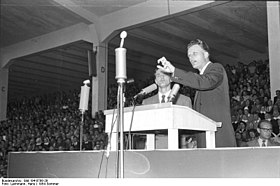

In the U.S. and elsewhere in the world, there has been a marked rise in the
The
Evangelicalism is not a single, monolithic entity. The Evangelical churches and their adherents cannot be easily stereotyped. Most are not fundamentalist, in the narrow sense that this term has come to represent; though many still refer to themselves as such. There have always been diverse views on issues, such as openness to cooperation with non-Evangelicals, the applicability of the Bible to political choices and social or scientific issues, and even the limited inerrancy of the Bible.
However, the movement has managed in an informal way, to reserve the name Evangelical for those who adhere to an historic Christian faith, a paleo-orthodoxy, as some have put it. Those who call themselves "moderate evangelicals" (although considered conservative in relation to society as a whole) still hold to the fundamentals of the historic Christian faith. Even "Liberal" Evangelicals label themselves as such not so much in terms of their theology, but rather to advertise that they are progressive in their civic, social, or scientific perspective.
There is some debate as to whether
Evangelicals are as diverse as the names that appear—
Spread of secularism

- Europe
In Europe there has been a general move away from religious observance and belief in Christian teachings and a move towards secularism. The "secularization of society", attributed to the time of the Enlightenment and its following years, is largely responsible for the spread of secularism. For example, the Gallup International Millennium Survey [1] showed that only about one sixth of Europeans attend regular religious services, less than half gave God "high importance", and only about 40% believe in a "personal God". Nevertheless, the large majority considered that they "belong" to a religious denomination.
- The Americas and Australia
In North America, South America and Australia, the other three continents where Christianity is the dominant professed religion, religious observance is higher than in Europe. At the same time, these regions are often seen by other nations as being uptight and "Victorian", in their social mores.[citation needed] In general, the United States leans toward the conservative in comparison to other western nations in its general culture, in part due to the Christian element found primarily in its Midwestern and southern states.
South America, historically Catholic, has experienced a large Evangelical and Pentecostal infusion in the 20th century due to the influx of Christian missionaries from abroad. For example: Brazil, South America's largest country, is the largest Catholic country in the world, and at the same time is the largest Evangelical country in the world (based on population).[citation needed] Some of the largest Christian congregations in the world are found in Brazil.
See also
- Christianity in the 16th century
- Christianity in the 17th century
- Christianity in the 18th century
- Christianity in the 19th century
- Christianity in the 20th century
- Christianity in the 21st century
- Heresy in Christianity#Second millennium
- History of Christianity of the Late Modern era
- History of the Roman Catholic Church
- Revival (religious)
- Timeline of Christianity
Notes
References
- ISBN 978-1-4067-6712-4.
- ^ "Philip Schaff: History of the Christian Church, Volume III: Nicene and Post-Nicene Christianity. A.D. 311–600 – Christian Classics Ethereal Library". ccel.org. Retrieved 29 January 2022.
- ^ a b c "John Wycliffe's Life and Work". Christianity.com. Retrieved 13 May 2023.
- ^ a b "John Huss". Christian History | Learn the History of Christianity & the Church. Retrieved 13 May 2023.
- ^ a b "Jan Hus | Encyclopedia.com". www.encyclopedia.com. Retrieved 13 May 2023.
- ^ Blunt, John Henry (1869). The reformation of the Church of England; its history, principles, and results. Oxford University. London, Rivingtons. p. 400.
- ISBN 978-90-04-09465-9.
- ^ "This monumental work is to this day the classic Protestant answer to Trent." from page three of Martin Chemnitz on the Doctrine of Justification by Jacob A. O. Preus
- ^ Examen, Volumes I–II: Volume I begins on page 46 of the pdf and Volume II begins on page 311. Examen Volumes III-IV: Volume III begins on page 13 of the pdf and Volume IV begins on page 298. All volumes free on Google Books
- ^ Andrada, Diogo Paiva ¬de (1578). Defensio Tridentinae fidei cath: quinque libris comprehensa adv. Mart. Chemnitium (in Latin).
- ^ Žalta, Anja. 2004. Protestantizem in bukovništvo med koroškimi Slovenci. Anthropos 36(1/4): 1–23, p. 7.
- ISBN 978-0-674-03634-5.
- ISBN 0-19-211655-X.
- ^ Milner, Joseph. The History of the Church of Christ Volume 3.
A comment on the epistle to the Galatians, is his only work which was committed to the press. In it he every where asserts the equality of all the apostles with St. Peter. And, indeed, he always owns Jesus Christ to be the only proper head of the church. He is severe against the doctrine of human merits, and of the exaltation of traditions to a height of credibility equal to that of the divine word. He maintains that we are to be saved by faith alone; holds the fallibility of the church, exposes the futility of praying for the dead, and the sinfulness of the idolatrous practices then supported by the Roman see. Such are the sentiments found in his commentary on the epistle to the Galatians.
- ^ "Philip Schaff: History of the Christian Church, Volume IV: Mediaeval Christianity. A.D. 590–1073 – Christian Classics Ethereal Library". www.ccel.org. Retrieved 21 January 2022.
- ^ "Gottschalk Of Orbais | Roman Catholic theologian". Britannica.com. Retrieved 27 October 2021.
- ^ caryslmbrown (18 July 2017). "Reformation parallels: the case of Gottschalk of Orbais". Doing History in Public. Retrieved 27 October 2021.
- ^ Lockridge, Kenneth R. "Gottschalk "Fulgentius" of Orbais".
{{cite journal}}: Cite journal requires|journal=(help) - ^ "Ratramnus | Benedictine theologian | Britannica". www.britannica.com. Retrieved 21 November 2021.
- ^ Lützow, František (1911). . In Chisholm, Hugh (ed.). Encyclopædia Britannica. Vol. 14 (11th ed.). Cambridge University Press. pp. 7–8.
- ^ "Welcome". history.umbc.edu. Retrieved 13 May 2023.
- ^ Gstohl, Mark (2004). "The Magisterial Reformation". Theological Perspectives of the Reformation. Retrieved 27 June 2007.
- ^ "Roman Confutation (1530)". bookofconcord.org. Retrieved 13 May 2023.
- ^ Brecht, 2:325–34; Mullett, 197.
- S2CID 194015213.
- ^ "Hussites | Encyclopedia.com". www.encyclopedia.com. Retrieved 13 May 2023.
- ^ Plass, Ewald M. "Monasticism," in What Luther Says: An Anthology. St. Louis: Concordia Publishing House, 1959, 2:964.
- ^ Challenges to Authority: The Renaissance in Europe: A Cultural Enquiry, Volume 3, by Peter Elmer, page 25
- ^ "Martin Luther: Biography." AllSands.com. 26 July 2008 http://www.allsands.com/potluck3/martinlutherbi_ugr_gn.htm Archived 22 May 2011 at the Wayback Machine>.
- ^ "What ELCA Lutherans Believe." Evangelical Lutheran Church in America. 26 July 2008 "What ELCA Lutherans Believe". Archived from the original on 7 February 2009. Retrieved 28 January 2009..
- ^ Saraswati, Prakashanand. The True History and the Religion of India : A Concise Encyclopedia of Authentic Hinduism. New York: Motilal Banarsidass (Pvt. Ltd), 2001. "His 'protest for reformation' coined the term Protestant, so he was called the father of Protestantism."
- ^ Hillerbrand, Hans J. "Martin Luther: Significance," Encyclopædia Britannica, 2007.
- ^ Ewald M. Plass, What Luther Says, 3 vols., (St. Louis: CPH, 1959), 88, no. 269; M. Reu, Luther and the Scriptures, Columbus, Ohio: Wartburg Press, 1944), 23.
- ^ Luther, Martin. Concerning the Ministry (1523), tr. Conrad Bergendoff, in Bergendoff, Conrad (ed.) Luther's Works. Philadelphia: Fortress Press, 1958, 40:18 ff.
- ^ Fahlbusch, Erwin and Bromiley, Geoffrey William. The Encyclopedia of Christianity. Grand Rapids, MI: Leiden, Netherlands: Wm. B. Eerdmans; Brill, 1999–2003, 1:244.
- ^ Tyndale's New Testament, trans. from the Greek by William Tyndale in 1534 in a modern-spelling edition and with an introduction by David Daniell. New Haven, CT: Yale University Press, 1989, ix–x.
- ^ Bainton, Roland. Here I Stand: a Life of Martin Luther. New York: Penguin, 1995, 269.
- ^ Bainton, Roland. Here I Stand: a Life of Martin Luther. New York: Penguin, 1995, 223.
- ^ "Johann Tetzel," Encyclopædia Britannica, 2007: "Tetzel's experiences as a preacher of indulgences, especially between 1503 and 1510, led to his appointment as general commissioner by Albrecht, archbishop of Mainz, who, deeply in debt to pay for a large accumulation of benefices, had to contribute a considerable sum toward the rebuilding of St. Peter's Basilica in Rome. Albrecht obtained permission from Pope Leo X to conduct the sale of a special plenary indulgence (i.e., remission of the temporal punishment of sin), half of the proceeds of which Albrecht was to claim to pay the fees of his benefices. In effect, Tetzel became a salesman whose product was to cause a scandal in Germany that evolved into the greatest crisis (the Reformation) in the history of the Western church."
- ^ (Trent, l. c., can. xii: "Si quis dixerit, fidem justificantem nihil aliud esse quam fiduciam divinae misericordiae, peccata remittentis propter Christum, vel eam fiduciam solam esse, qua justificamur, a.s.")
- ^ (cf. Trent, Sess. VI, cap. iv, xiv)
- ^ Bainton, Roland. Here I Stand: a Life of Martin Luther. New York: Penguin, 1995, 60; Brecht, Martin. Martin Luther. tr. James L. Schaaf, Philadelphia: Fortress Press, 1985–1993, 1:182; Kittelson, James. Luther The Reformer. Minneapolis: Augsburg Fortress Publishing House, 1986),104.
- ^ Krämer, Walter and Trenkler, Götz. "Luther," in Lexicon van Hardnekkige Misverstanden. Uitgeverij Bert Bakker, 1997, 214: 216.
- ^ Ritter, Gerhard. Luther, Frankfurt 1985.
- ^ Gerhard Prause "Luthers Thesanschlag ist eine Legende," in Niemand hat Kolumbus ausgelacht. Düsseldorf, 1986.
- ^ Brecht, Martin. Martin Luther. tr. James L. Schaaf, Philadelphia: Fortress Press, 1985–1993, 1:204–205.
- ^ Brecht, Martin. (tr. Wolfgang Katenz) "Luther, Martin," in Hillerbrand, Hans J. (ed.) Oxford Encyclopedia of the Reformation. New York: Oxford University Press, 1996, 2:463.
- ^ Daniels, David D. (2 November 2017). "Martin Luther and Ethiopian Christianity: Historical Traces". University of Chicago. Retrieved 9 April 2018.
In that year Luther welcomed a new voice into his ecumenical dialogue: Michael the Deacon, an Ethiopian cleric. Recalling his dialogue with Michael, Luther stated: "We have also learned from him, that the rite which we observe in the use of administration of the Lord's Supper and the Mass, agrees with the Eastern Church". Luther expressed his approval of the Church of Ethiopia along with his embrace of Deacon Michael in a letter dated 4 July 1534: "For this reason we ask that good people would demonstrate Christian love also to this [Ethiopian] visitor". According to Luther, Michael responded positively to his articles of the Christian faith, proclaiming: "This is a good creed, that is, faith" (see Martin Luther, Table-Talk, 17 November 1538 [WA, TR 4:152–153, no. 4126]).
- ^ Luther Digest: An Annual Abridgment of Luther Studies, Volumes 2–4. Luther Academy. 1994. p. 146.
During the summer of 1534, an Ethiopian monk Deacon Michael visited Wittenberg. With great satisfaction Luther recorded that among the Christians in Ethiopia neither the private Mass nor the Mass canon was known, and their order of service generally corresponded to that of evangelical congregations of Germany (WA Tr 5:450, #6045).
- ^ Daniels, David D. (31 October 2017). "Martin Luther's fascination with Ethiopian Christianity". The Christian Century. Retrieved 9 April 2018.
For his part, after having Luther's Articles of the Christian Faith interpreted to him, Deacon Michael proclaimed: "This is a good creed, that is, faith".
- ^ Daniels, David D. (28 October 2017). "Martin Luther's 'dream' church? It wasn't in Europe". Religion News Service. Retrieved 9 April 2018.
- ^ Daniels, David D. (21 October 2017). "Honor the Reformation's African roots". The Commercial Appeal. Retrieved 9 April 2018.
- ^ a b c "THE REFORMATION IN GERMANY AND SCANDINAVIA". vlib.iue.it. Retrieved 13 May 2023.
- ^ Fabian Rimfors; Marie-Louise Rodén (2 June 2017). "500-årsjubileum för den protestantiska reformationen" [500th anniversary of the Protestant Reformation]. Kristianstad University. Kristianstad. Archived from the original on 2 June 2023. Retrieved 8 March 2024.
Sverige var den första nationalstaten att införa protestantismen, redan 1527 vid den så kallade Reformationsriksdagen i Västerås.
- ^ Article 1, of the Articles Declaratory of the Constitution of the Church of Scotland 1921 states 'The Church of Scotland adheres to the Scottish Reformation'.
- ^ Holt, Mack P. (1995). The French Wars of Religion, 1562–1629. Cambridge: Cambridge University Press. pp. 21–22.
- ^ France. Parlement (Paris), N. (Nathanaël) Weiss, and Société de l'histoire du protestantisme français (France) (1889). La Chambre Ardente (in French). Paris: Fischbacher. p. XXXIV. Retrieved 9 February 2019.
{{cite book}}: CS1 maint: multiple names: authors list (link) - ^ Baird, Henry M. (1891). The "Chambre Ardente" and French Protestantism under Henry II. New York. p. 404. Retrieved 9 February 2019.
{{cite book}}: CS1 maint: location missing publisher (link) - ^ France. Parlement (Paris), N. (Nathanaël) Weiss, and Société de l'histoire du protestantisme français (France) (1889). La Chambre Ardente (in French). Paris: Fischbacher. p. LXXII. Retrieved 9 February 2019.
{{cite book}}: CS1 maint: multiple names: authors list (link) - ^ "St. Bartholomew's Day Massacre, Paris in Conflict and contemporary coin". home.eckerd.edu. Retrieved 13 May 2023.
- ^ Revesz, Imre, History of the Hungarian Reformed Church, Knight, George A.F. ed., Hungarian Reformed Federation of America (Washington, D.C.: 1956).
- ^ "The Forgotten Reformations in Eastern Europe – Resources". www.eldrbarry.net. Retrieved 13 May 2023.
- ISBN 9781443843850.
- ^ Kenneth Scott Latourette, Christianity in a Revolutionary Age, II: The Nineteenth Century in Europe: The Protestant and Eastern Churches (1959) pp. 428–431
- ^ Owen Chadwick, Victorian Church (2 vol. 1979)
- ^ Thomas Jay Williams, Priscilla Lydia Sellon: the restorer after three centuries of the religious life in the English church (SPCK, 1965).
- ^ Christopher Clark, Iron Kingdom (2006) pp. 412–419
- S2CID 159976974.
- ^ Hajo Holborn, A History of Modern Germany 1648–1840 (1964) pp. 485–491
- ^ Sydney E. Ahlstrom, A Religious History of the American People. (New Haven and London: Yale University Press, 1972) p. 263
- ^ Matzko, John (2007). "The Encounter of the Young Joseph Smith with Presbyterianism". Dialogue: A Journal of Mormon Thought. 40 (3): 68–84. Presbyterian historian Matzko notes that "Oliver Cowdery claimed that Smith had been 'awakened' during a sermon by the Methodist minister George Lane."
- ISBN 0-226-25662-6. excerpt
- ^ Jane Addams, Twenty Years at Hull House; Edmund Wilson, The American Earthquake.
- ISBN 978-1-4443-9770-3
- ISBN 978-0-415-06043-1
- ^ "Find a church". Evangelical Alliance. Retrieved 13 May 2023.
Further reading
- Ahlstrom, Sydney E. A Religious History of the American People (1972, 2nd ed. 2004); widely cited standard scholarly history excerpt and text search
- Chadwick, Owen. A History of Christianity (1995)
- Gilley, Sheridan, and Brian Stanley, eds. The Cambridge History of Christianity: Volume 8, World Christianities c.1815 – c.1914 (2006) excerpt
- González, Justo L. (1985). The Story of Christianity, Vol. 2: The Reformation to the Present Day. San Francisco: Harper. ISBN 0-06-063316-6.
- Hastings, Adrian (1999). A World History of Christianity. Wm. B. Eerdmans Publishing. ISBN 0-8028-4875-3.
- Hillerbrand, Hans J. ed. Encyclopedia of Protestantism (4 vol 2004) excerpt
- Latourette, Kenneth Scott (1975). A History of Christianity, Volume 2: 1500 to 1975. San Francisco: Harper. ISBN 0-06-064953-4.
- Latourette, Kenneth Scott. Christianity in a Revolutionary Age, I: The Nineteenth Century in Europe: Background and the Roman Catholic Phase; Christianity in a Revolutionary Age, II: The Nineteenth Century in Europe: The Protestant and Eastern Churches; Christianity in a Revolutionary Age, III: The Nineteenth Century Outside Europe: The Americas, the Pacific, Asia and Africa (1959–1969), detailed survey by leading scholar
- Lippy, Charles H., ed. Encyclopedia of the American Religious Experience (3 vol. 1988)
- MacCulloch, Diarmaid. Christianity: The First Three Thousand Years (2011)
- MacCulloch, Diarmaid. The Reformation (2005) excerpt
- McLeod, Hugh and Werner Ustorf, eds. The Decline of Christendom in Western Europe, 1750–2000 (Cambridge UP, 2004) online
- Marshall, Peter. The Reformation: A Very Short Introduction (2009)
- Noll, Mark A. A History of Christianity in the United States and Canada (1992)
- Rosman, Doreen. The Evolution of the English Churches, 1500–2000 (2003) 400pp
- Ryrie, Alec. Protestants: The Faith That Made the Modern World (2017) excerpt, covers last five centuries
- Winship, Michael P. Hot Protestants: A History of Puritanism in England and America (Yale UP, 2019) excerpt
- Wylie, James Aitken. The History of Protestantism (3 vol. 1899) online free
External links
 Media related to History of Protestantism at Wikimedia Commons
Media related to History of Protestantism at Wikimedia Commons
The following links give an overview of the history of Christianity:
- Dictionary of the History of Ideas: Christianity in History
- Dictionary of the History of Ideas: Church as an Institution
- Phillips, Walter Alison (1911). . Encyclopædia Britannica. Vol. 6 (11th ed.). pp. 330–345.
The following link provides quantitative data related to Christianity and other major religions, including rates of adherence at different points in time:
- American Religion Data Archive
- Historical Christianity, A time line with references to the descendants of the early church.

